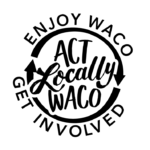By Gracie Arias
“This isn’t for the faint of heart” have you ever heard that before?
That’s what I feel like sometimes in this journey of supporting an artist. I have seen Carlos, my husband, also known professionally as “The Masterpiece,” grow in his artistic abilities in the 10 years I have known him. I feel blessed by that and I wouldn’t give it up for anything.
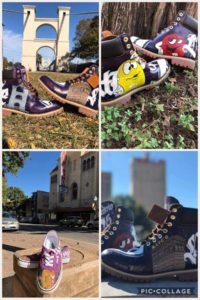 When I first met him, I saw a pair of shoes he was wearing that he had painted…the first pair, and now he’s done over 100! So then, The Masterpiece was created! That hasn’t always come easy. Sometimes it means staying up until the early morning hours completing an order, and waking up early for a full- time job. But, as they also say, “hard work pays off”! Since April 2017, The Masterpiece hasn’t had a break once, and that’s something we are more than ok with! That means people are seeing his talents and wanting a part of it. And not just shoes either, so many different things. Such as, murals and windows at Enve beauty bar on Austin Avenue, or a more recent one at The Chatterbox in downtown. Also, weddings and parties, baby showers, and signs. So much going on! It’s a very exciting time to be an artist in Waco, so much brewing and changing, art is in the air here.
When I first met him, I saw a pair of shoes he was wearing that he had painted…the first pair, and now he’s done over 100! So then, The Masterpiece was created! That hasn’t always come easy. Sometimes it means staying up until the early morning hours completing an order, and waking up early for a full- time job. But, as they also say, “hard work pays off”! Since April 2017, The Masterpiece hasn’t had a break once, and that’s something we are more than ok with! That means people are seeing his talents and wanting a part of it. And not just shoes either, so many different things. Such as, murals and windows at Enve beauty bar on Austin Avenue, or a more recent one at The Chatterbox in downtown. Also, weddings and parties, baby showers, and signs. So much going on! It’s a very exciting time to be an artist in Waco, so much brewing and changing, art is in the air here.
One thing that Carlos has definitely shown me, is that when you have a dream, do your best and make it reality. Because of his encouragement, I participated in the first ever Central Texas Artist Collective (CTAC) exhibit “Ekphrasis: Art & Words,” and it reminded me why I love writing. So, that’s when Gracefulmess blog was born.
I wanted a safe place to put my thoughts, goals, and hurts down on. It’s opened a new door to healing for me, and others! I’ve received so many messages and comments explaining how it has helped them. Now I have so many goals to the direction that it’s heading and I’m so excited.
I say all this in hope that it will encourage someone. We are parents, we are young, and we are introverts. The opportunities that we have now did not come easy. We had to leave our little bubble of familiarity and comfort, and reach for it. Really jump into it, ok more like dive. There are so many opportunities here in Waco that will give you a chance for growth. If you have a talent, no matter what it is, don’t let it go to waste. Plug in somewhere and flourish! Don’t wait for someone to give you that push but instead push yourself! Go and create!
 Gracie Arias, wife and mom. Blogger. Future massage therapist. The feeling of accomplishment is one of the best feelings to feel. I’m working hard to reach my goals and to support those I love to reach theirs too. Life should be watched on the sidelines, but lived with all your heart and strength. Www.Gracefulmess.wordpress.com
Gracie Arias, wife and mom. Blogger. Future massage therapist. The feeling of accomplishment is one of the best feelings to feel. I’m working hard to reach my goals and to support those I love to reach theirs too. Life should be watched on the sidelines, but lived with all your heart and strength. Www.Gracefulmess.wordpress.com
By Brooke Davilla
“What is wrong with this kid?” as a caregiver, teacher, tutor, pastor, have you ever found yourself thinking that? Maybe you are working with a child and you just can’t seem to get through…their behavior is baffling to you…you’ve tried everything you know how to do, but you just can’t seem to figure out how to connect with them. Maybe it’s time for a new question. Specialists in child development are starting to learn that Instead of asking “What is wrong with this kid?,” sometimes it’s more helpful to ask ourselves, “What has happened to this person?”
We are created for connection, every single one of us, young and old. Connection is crucial for having quality relationships throughout our life span. However, due to the effects of trauma, such as difficult pregnancy or birth, early medical interventions, as well as abuse and neglect, children who come from a hard place often have a hard time connecting. They have a different brain, beliefs, behaviors, body and biology which may contribute to the display of negatives behaviors such as outbursts, irritability and dysregulation. Many times as caregivers we focus on behavior management techniques that don’t always work, leaving both the caregiver and child further disconnected. Trust Based Relational Intervention® (TBRI®) offers practical strategies for caregivers to see the core needs behind the behaviors. Research indicates that when caregivers attend to the mind, body and spiritual needs of a child, connection increases and negative behaviors decrease. With a focus on cultivating trust between the caregiver and child, TBRI® methods increase the overall felt-safety, connection and capacity for self-regulation which are the pillars of trauma informed care.
 If you have found yourself asking, “What’s wrong with this kid?,” we invite you to join us for the Empowered to Connect Conference Simulcast presented by Show Hope and the Karyn Purvis Child Institute on April 13-14th. Come experience practical teaching in a safe and supportive community as we work to equip families, churches, and professionals to better serve children impacted by adoption, foster care or trauma. Featuring Trust-Based Relational Intervention® methods, this conference will strengthen attachment and connection in families.
If you have found yourself asking, “What’s wrong with this kid?,” we invite you to join us for the Empowered to Connect Conference Simulcast presented by Show Hope and the Karyn Purvis Child Institute on April 13-14th. Come experience practical teaching in a safe and supportive community as we work to equip families, churches, and professionals to better serve children impacted by adoption, foster care or trauma. Featuring Trust-Based Relational Intervention® methods, this conference will strengthen attachment and connection in families.
Date: April 13th and 14th
Time: 9AM- 5PM
Cost: Free
Location: Methodist Children’s Home, Mulkey Building | 201 Faith Way | Waco, TX 76708
Registration: https://www.eventbrite.com/o/mch-family-outreach-waco-13073900133
MCH Family Outreach Waco utilizes TBRI® along with other trauma informed curricula to offer support to families and community partners through in-home case management services, parent education classes and community-based trainings. If you are interested in learning how we can offer support to your family, agency, school or congregation please contact Brooke Davilla at [email protected] or 254-750-1263.
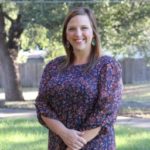 Brooke Davilla is the Director of MCH Family Outreach Waco for Methodist Children’s Home. She graduated from Baylor University with a MSW in Social Work, concentration in Community Practice, where she now teaches part-time. Brooke is passionate about cultivating a trauma informed community and is a TBRI® Practitioner. She enjoys spending time with her husband and two sons traveling, being in nature and often at the baseball fields. You can reach Brooke at [email protected].
Brooke Davilla is the Director of MCH Family Outreach Waco for Methodist Children’s Home. She graduated from Baylor University with a MSW in Social Work, concentration in Community Practice, where she now teaches part-time. Brooke is passionate about cultivating a trauma informed community and is a TBRI® Practitioner. She enjoys spending time with her husband and two sons traveling, being in nature and often at the baseball fields. You can reach Brooke at [email protected].
The Act Locally Waco blog publishes posts with a connection to these aspirations for Waco. If you are interested in writing for the Act Locally Waco Blog, please email [email protected] for more information.
(During these last few weeks of December we will be reprising the Top 10 Most Opened Blog Posts for 2018 from the Act Locally Waco blog. I couldn’t possibly pick my favorites – so I used the simple (cop out?) approach of pulling up the 10 blog posts that got the most “opens” according to our Google Analytics. It is an intriguing collection that gives at least a little insight into the interests and concerns of Act Locally Waco readers. I hope this “Top 10” idea inspires you to go back and re-read your personal favorites. There have been so many terrific ones… If you would like to see the Top 10 according to Google Analytics, here’s the link: Top 10 Most Opened Blog Posts of 2018. Merry Christmas! — ABT)
by Berkeley Anderson and Geneece Goertzen
When someone gets mugged, we don’t say, “That suit you were wearing was a bad idea. It just screams ‘I’ve got money, rob me.’ We don’t ask victims, ‘What did you expect to happen when you had a wallet full of money? You were just asking to be robbed.’”
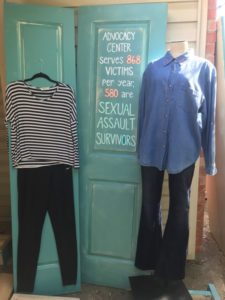 So why do Sexual Assault victims face a barrage of questions that imply they are to blame for their own attack? “Were you drinking? Why did you go out alone? Why did you let your attacker into your room?”
So why do Sexual Assault victims face a barrage of questions that imply they are to blame for their own attack? “Were you drinking? Why did you go out alone? Why did you let your attacker into your room?”
And, of course, “Well, what were you wearing?”
The impact of these questions is difficult to quantify, but it shows up in survivors blaming themselves for their own assault. It shows up in rapists getting away with what should be easily prosecuted cases. It shows up in negative mental health outcomes for victims. It shows up in victims fearing to report the assault to police.
When assessing sexual violence, the only question that matters is consent. But rape culture–the normalization of sexual violence– causes some people to assert that clothing matters, shifting the focus off the obvious reason for the assault: that the attacker was a rapist.
April is recognized as National Sexual Assault Awareness Month which raises awareness about sexual violence, educates communities and individuals on how to prevent it, supports and empowers survivors, and strengthens the culture of consent.
According to the National Sexual Violence Resource Center, consent is an enthusiastic, ongoing, clearly communicated affirmative agreement to engage in various sexual or non-sexual activities. Past consent does not equal current consent. The absence of a “no” does not equal a “yes.” A person who is impaired cannot give consent. A child cannot consent. When sex is consensual, it means that the involved parties have granted permission. Non-consensual sex is rape.
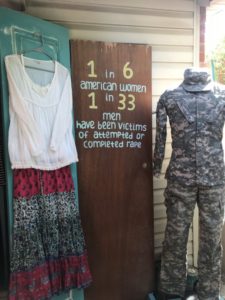 Sexual Assault affects people across all demographics. Although rape and sexual assault are often thought of as being committed by strangers in a dark alley, that is seldom the case. Most victims of sexual assault know their attacker. This is especially true for children. Neither is rape limited to young adult females. Women, men, and children of both genders experience rape and sexual assault. It happens in heterosexual relationships, and it happens among the LGBTQ community. It happens to the young and the old. It happens to the rich and poor. It happens within all religions and ethnic origins. It happens to singles, and it even happens within marriage. Every 98 seconds, an American is sexually assaulted.
Sexual Assault affects people across all demographics. Although rape and sexual assault are often thought of as being committed by strangers in a dark alley, that is seldom the case. Most victims of sexual assault know their attacker. This is especially true for children. Neither is rape limited to young adult females. Women, men, and children of both genders experience rape and sexual assault. It happens in heterosexual relationships, and it happens among the LGBTQ community. It happens to the young and the old. It happens to the rich and poor. It happens within all religions and ethnic origins. It happens to singles, and it even happens within marriage. Every 98 seconds, an American is sexually assaulted.
A powerful art exhibit, “What were you wearing Waco” on display through April, aims to debunk the myth that clothing caused the assault, by featuring representations of what victims were wearing at the time of their attack. The exhibit seeks to open doors in an attempt to combat victim-blaming, promote awareness, and destroy stereotypes about rape and sexual assault.
“What Were You Wearing, Waco?“ kicks off with an opening night event in conjunction with First Friday Waco at The Warehouse, 727 Austin Avenue. It will then move to different locations in Waco.
- Opening Night, April 6th at 6pm
- Austin’s on the Ave, April 5-14th, 3pm to 12am
- Outside Baylor Sub, April 16-26th, from 8am to 5pm
- At local churches & organizations throughout the month of April
- Closing Night, April 27 at 5pm at Jesus Said Love
There is also a traveling portion of the exhibit. If you would like a piece of the exhibit to advertise “What Were You Wearing” at your church, school, or business, please email [email protected].
The original “What Were You Wearing” project was created in 2013 by Jen Brockman, director of KU’s Sexual Assault Prevention and Education Center, and Dr. Mary A. Wyandt-Heibert, who oversees the University of Arkansas’ rape education center. Born out of an advocacy ideal, the installation asks participants to understand that it is never about the clothing, and ending sexual violence is not as easy as changing our clothes.
List of Resources:
If you or someone you know has been Sexually Assaulted, you can call the Advocacy Center for Crime Victims and Children at (254) 752-9330. Their crisis hotline is available 24/7 at (888) 867-7233.
If you or someone you know is a victim of Domestic Violence, you can call the Family Abuse Center at (254) 772-8999. Or you can contact the 24-hour hotline at (800) 283-8401.
Baylor’s Title IX department: 254-710-8454 or visit, https://www.baylor.edu/titleIX/
 Geneece Goertzen is on the Board of Directors for the Family Abuse Center, and has a passion for victim advocacy. She has worked as costume designer for many of the recent shows at Waco Civic Theatre, as well as having created many historical costumes over the last decade.
Geneece Goertzen is on the Board of Directors for the Family Abuse Center, and has a passion for victim advocacy. She has worked as costume designer for many of the recent shows at Waco Civic Theatre, as well as having created many historical costumes over the last decade.
 Berkeley Anderson has a Master’s degree in public service and degrees in physics and history. She loves slam poetry, hot sauce, and any dog she meets. She is the Teen Dating Violence Project Manager at the Family Abuse Center.
Berkeley Anderson has a Master’s degree in public service and degrees in physics and history. She loves slam poetry, hot sauce, and any dog she meets. She is the Teen Dating Violence Project Manager at the Family Abuse Center.
The Act Locally Waco blog publishes posts with a connection to these aspirations for Waco. If you are interested in writing for the Act Locally Waco Blog, please email [email protected] for more information.
By Jessica Russell Morrow
I have lived in Waco, Texas, since July 2012 and am a mother to two Boys (2 ½ and 5 months).
When I was a kid, my parents enrolled me in tons of extracurricular activities including softball, piano, basketball, bowling and golf. However, the one activity that stuck with me the most was Soccer. I grew up idolizing Mia Hamm, Brandi Chastain, Julie Foudy, Kristine Lilly, Joy Fawcett and Abby Wambach.
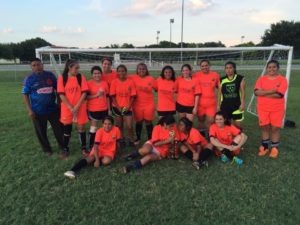 My interest in the sport was kindled by a supportive environment. I played throughout high school for both my high school and the Olympic Development Program. I remember the bittersweet moment of taking of my cleats at the end of the championship game my senior year of high school thinking, “This is it, I guess I won’t need these anymore.” I thought about giving away my cleats and shin guards. If I wasn’t going to play in college why would I ever need them again?
My interest in the sport was kindled by a supportive environment. I played throughout high school for both my high school and the Olympic Development Program. I remember the bittersweet moment of taking of my cleats at the end of the championship game my senior year of high school thinking, “This is it, I guess I won’t need these anymore.” I thought about giving away my cleats and shin guards. If I wasn’t going to play in college why would I ever need them again?
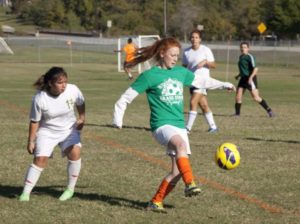 I ended up packing my cleats when I left for college thinking that there was a tiny chance I would get to use them again. Within the first week I found myself making new friends and playing pickup games. I ended up joining a co-ed intramural team that stuck together through college. After college I was sure that my soccer playing really was at an end. However, I was wrong again as I found pickup games and co-ed leagues for adults almost immediately. When I moved to Boston for graduate school there were so many different adult soccer leagues for me to join I could play every day of the week if I wanted. In 2012, my husband and I picked up our lives moved to Waco, Texas. It took me several months to adjust to the heat before finding the Waco Women’s Soccer League.
I ended up packing my cleats when I left for college thinking that there was a tiny chance I would get to use them again. Within the first week I found myself making new friends and playing pickup games. I ended up joining a co-ed intramural team that stuck together through college. After college I was sure that my soccer playing really was at an end. However, I was wrong again as I found pickup games and co-ed leagues for adults almost immediately. When I moved to Boston for graduate school there were so many different adult soccer leagues for me to join I could play every day of the week if I wanted. In 2012, my husband and I picked up our lives moved to Waco, Texas. It took me several months to adjust to the heat before finding the Waco Women’s Soccer League.
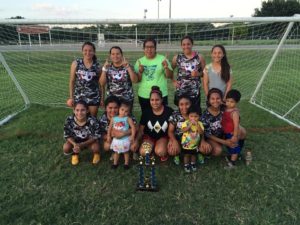 The Waco Women’s Soccer League is a Saturday morning soccer league that plays across the street from the HOT soccer fields off Airport Road. The league is run by a few dedicated volunteers and functions with the help of a great relationship with the Texas Association of Sports Officials. Games are 7v7 including goalies. All the players in the league are busy women with a passion for playing. Unlike the sports I played growing up, we don’t practice during the week. Players show up ready to have fun and dedicate themselves to two 30 minute halves before going about the rest of their Saturday.
The Waco Women’s Soccer League is a Saturday morning soccer league that plays across the street from the HOT soccer fields off Airport Road. The league is run by a few dedicated volunteers and functions with the help of a great relationship with the Texas Association of Sports Officials. Games are 7v7 including goalies. All the players in the league are busy women with a passion for playing. Unlike the sports I played growing up, we don’t practice during the week. Players show up ready to have fun and dedicate themselves to two 30 minute halves before going about the rest of their Saturday.
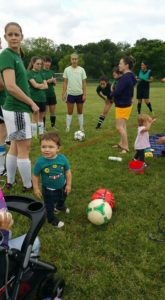 I have played with a team called the Grass Stains since finding this league. My team ranges in age from 19 to late 40s. Since joining, I have met many wonderful women and learned the power of women supporting women. This team has provided invaluable support to its players on and off the field. Off the field we have had players graduate high school, college, graduate, and law school; get married; have babies and return to playing after having babies; suffer injuries (both related and unrelated to soccer); complete marathons, triathlons and road races; and travel the world.
I have played with a team called the Grass Stains since finding this league. My team ranges in age from 19 to late 40s. Since joining, I have met many wonderful women and learned the power of women supporting women. This team has provided invaluable support to its players on and off the field. Off the field we have had players graduate high school, college, graduate, and law school; get married; have babies and return to playing after having babies; suffer injuries (both related and unrelated to soccer); complete marathons, triathlons and road races; and travel the world.
We have women who played Division 1 collegiate soccer passing along with 18 year olds fresh out of high school soccer. We have players who haven’t touched a soccer ball in a decade and those who find a way to play every day of the week. We have moms, daughters, yogis, runners, cross fitters, triathletes, bikers, artists, singers, wives, lawyers, nurses, doctors, teachers, coaches, veterinarians, professors, students, chefs, administrative assistants, restaurant servers, and UPS managers. However, our identity off the field doesn’t matter as we all share a common love for the game of soccer.
The Spring 2018 season is about to start and I am excited to get out there and look like an idiot as it will be my first full season since having my second son 5 months ago. I have done this post-partum journey before as I have a 2 ½ year old boy. I love having my sons on the sidelines cheering me on. My team has an entire cheering section with Husbands, Pets, Babies, Toddlers, Parents and friends. Teams recognize that family is important and many take turns watching kids on the sidelines while moms go play. We have several Dads who come to help on the sidelines as well.
I now have two boys, a 2 ½ year old and a 5-month-old. I am excited to introduce them to some of my passions and hope to be able to encourage them to develop a lifelong passion and excitement for something. My two year old is always watching what I do, so I am proud to have him watch me participate in sports. Sports, in general, has provided me with a therapeutic outlet and allowed me to make friends in where ever I go. Maybe my kids will like soccer, maybe they will enjoy something else… all current signs point to a passion for eating cheese and knocking over blocks.
Maybe athletics isn’t your outlet, but If it is, I encourage you to try out one of the many family friendly sports opportunities in Waco. So, ladies…Come Out and Play!
The Spring Season starts forming teams April 7th! (Just show up at 9 AM and we can get you placed on a team). Signing up doesn’t actually commit you to playing every Saturday. Many teams have players come when they can.
What to Bring:
- Shin Guards (must be worn during regular season games)
- Water Bottle
- $35 for League Fees
- Cleats (recommended)
- Goalie Gloves (if interested in a goalie position)
This great organization offers all kinds of adult sports ranging from volleyball to dodgeball to flag football
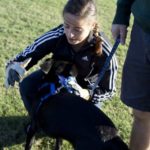 Jessica Morrow grew up in a military family and had the opportunity to live many places including California, Washington, Virginia, South Korea, Italy, Germany and Belgium. She settled in the U.S. after high school and attended James Madison University in Harrisonburg, Virginia where she earned a B.A. in English. She then went on to earn an M.A. in English at Northeastern University in Boston, Massachusetts. She moved with her (then) fiancé to Waco, Texas in 2012. He works as an Engineer at SpaceX. Jessica is currently the Assistant Director of Stewardship at Baylor University. Jessica and her Husband have two boys, (age 2 ½ and 5 months). She enjoys Hanging out with her family, Playing soccer, Running, Travelling, CrossFit and Yoga.
Jessica Morrow grew up in a military family and had the opportunity to live many places including California, Washington, Virginia, South Korea, Italy, Germany and Belgium. She settled in the U.S. after high school and attended James Madison University in Harrisonburg, Virginia where she earned a B.A. in English. She then went on to earn an M.A. in English at Northeastern University in Boston, Massachusetts. She moved with her (then) fiancé to Waco, Texas in 2012. He works as an Engineer at SpaceX. Jessica is currently the Assistant Director of Stewardship at Baylor University. Jessica and her Husband have two boys, (age 2 ½ and 5 months). She enjoys Hanging out with her family, Playing soccer, Running, Travelling, CrossFit and Yoga.
By Aranza Torres and Jon Singletary
With a commitment to inspiring, guiding, and connecting young leaders in Waco ISD, Superintendent Marcus Nelson introduced the first Empowerment Summits for Young Men and Young Women. Campus staff and administrators identified approximately 450 students in grades seven through 12 as future leaders from seven Waco ISD campuses.
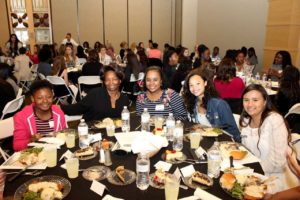 Students had the opportunity to hear from local experts in the medical, legal and educational fields on topics ranging from managing stress, social media, sexual violence, college access and leadership development during panel-style discussions. At the Women’s Empowerment Summit, Jolanda Jones, a Houston ISD trustee, former city council member, author, attorney and former All-American athlete and member of the United States track and field team, served as the keynote speaker. Jones was also a former contestant on “Survivor” and star of WEtv’s “Sisters in Law.”
Students had the opportunity to hear from local experts in the medical, legal and educational fields on topics ranging from managing stress, social media, sexual violence, college access and leadership development during panel-style discussions. At the Women’s Empowerment Summit, Jolanda Jones, a Houston ISD trustee, former city council member, author, attorney and former All-American athlete and member of the United States track and field team, served as the keynote speaker. Jones was also a former contestant on “Survivor” and star of WEtv’s “Sisters in Law.”
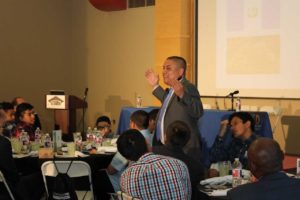 Jaime Carias, the keynote speaker for the men, is the Civic Engagement Coordinator at the University of Southern California Annenberg School for Communication and Journalism. Carias is also a leading urban educator, author and national speaker who is well known for his ability to inspire and educate students of all ages.
Jaime Carias, the keynote speaker for the men, is the Civic Engagement Coordinator at the University of Southern California Annenberg School for Communication and Journalism. Carias is also a leading urban educator, author and national speaker who is well known for his ability to inspire and educate students of all ages.
Approximately 75 men and women from the Central Texas area representing various professions and community organizations volunteered as table hosts to provide a strong leadership presence and facilitate conversations with the attendees. The following reflections are from two of our table hosts. – Robin McDurham, Assistant Superintendent of Student Services & Family Engagement
Empowerment Summit for Young Women
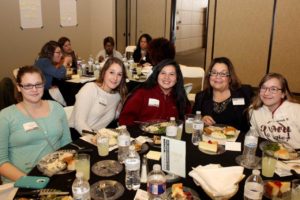 As a college recruiter, I have the privilege of walking students and families through the transition from high school to college. Occasionally I am given the opportunity to participate in community events such as the Waco ISD Young Women’s Empowerment Summit on February 23rd. As a table host, I had the pleasure of meeting 8 wonderful young leaders who were hand-selected by their campuses to participate in the summit. Our table included students from different campuses and of varying grade levels. It was great to witness them get to know one another, share related experiences and provide advice and encouragement. I was thrilled to hear of the many ways these bright young women demonstrate their leadership through school clubs, dual credit classes, athletics and additional community opportunities.
As a college recruiter, I have the privilege of walking students and families through the transition from high school to college. Occasionally I am given the opportunity to participate in community events such as the Waco ISD Young Women’s Empowerment Summit on February 23rd. As a table host, I had the pleasure of meeting 8 wonderful young leaders who were hand-selected by their campuses to participate in the summit. Our table included students from different campuses and of varying grade levels. It was great to witness them get to know one another, share related experiences and provide advice and encouragement. I was thrilled to hear of the many ways these bright young women demonstrate their leadership through school clubs, dual credit classes, athletics and additional community opportunities.
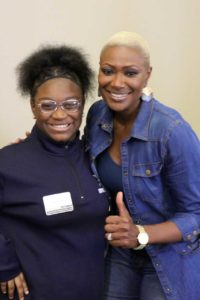 I enjoyed the time I spent with my group and gained new insights thanks to the excellent speakers. The panelists covered a number of relevant topics including; social media, sexual violence and consent, college readiness, stress management and personal development. They were able to offer concrete advice and action steps students could take now. One of my personal highlights of the morning was the keynote speaker, Jolanda Jones, whose powerful and resilient life experiences are a testament to the power of hard work and the importance of finding confidence in one’s self. I feel very lucky to have been invited to the summit and have shared this time with my group.
I enjoyed the time I spent with my group and gained new insights thanks to the excellent speakers. The panelists covered a number of relevant topics including; social media, sexual violence and consent, college readiness, stress management and personal development. They were able to offer concrete advice and action steps students could take now. One of my personal highlights of the morning was the keynote speaker, Jolanda Jones, whose powerful and resilient life experiences are a testament to the power of hard work and the importance of finding confidence in one’s self. I feel very lucky to have been invited to the summit and have shared this time with my group.
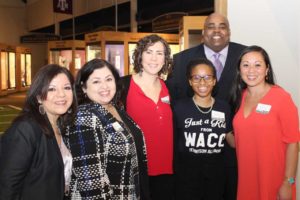 Young leaders are one of the best elements of our school campuses. Recognizing them in our community and investing in them is imperative. Ensuring that they feel supported and heard will serve to encourage their growth. We will look to these young leaders as they move to their next grade level, the college of their choice and contribute to our community. No matter where these young women end up I am confident that they will be hard-working and successful. – Aranza Torres
Young leaders are one of the best elements of our school campuses. Recognizing them in our community and investing in them is imperative. Ensuring that they feel supported and heard will serve to encourage their growth. We will look to these young leaders as they move to their next grade level, the college of their choice and contribute to our community. No matter where these young women end up I am confident that they will be hard-working and successful. – Aranza Torres
Empowerment Summit for Young Men
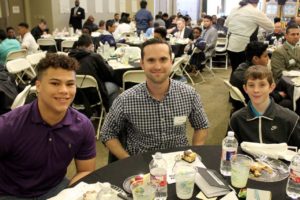 A few weeks ago, I had the opportunity to join a few local leaders on a panel as part of Dr. Marcus Nelson’s inaugural Young Men’s Empowerment Summit. Some eyes may have been on us, the panelists, but our eyes were on the amazing gathering of men in the room that day. Not only did three dozen men from Central Texas, representing a wide range of professions from accounting and law to medicine and ministry, come together in
A few weeks ago, I had the opportunity to join a few local leaders on a panel as part of Dr. Marcus Nelson’s inaugural Young Men’s Empowerment Summit. Some eyes may have been on us, the panelists, but our eyes were on the amazing gathering of men in the room that day. Not only did three dozen men from Central Texas, representing a wide range of professions from accounting and law to medicine and ministry, come together in  support of men’s empowerment, but more importantly were the 200 young men from Waco ISD schools who gathered. As those of us on the panel looked out on that room, we noticed the pride and confidence of the men, and the potential and hope that they represent. Too few young men in today’s culture are invited to reflect on the value of their past and even fewer have a clear expression of hope for their future. On that day, I saw that perspective shift in dozens of middle and high school men. As the panel reflected on social challenges from technology to sexuality, and as our guest speaker, Jaime Carias, shared his own journey of struggle and hope, these young men laughed, their eyes lit up, and they looked ahead at what their lives might hold. And, if this event is a glimpse of the future that Waco has with the leadership of these youth and the leadership of Dr. Nelson, then our future together is bright indeed. – Jon Singletary
support of men’s empowerment, but more importantly were the 200 young men from Waco ISD schools who gathered. As those of us on the panel looked out on that room, we noticed the pride and confidence of the men, and the potential and hope that they represent. Too few young men in today’s culture are invited to reflect on the value of their past and even fewer have a clear expression of hope for their future. On that day, I saw that perspective shift in dozens of middle and high school men. As the panel reflected on social challenges from technology to sexuality, and as our guest speaker, Jaime Carias, shared his own journey of struggle and hope, these young men laughed, their eyes lit up, and they looked ahead at what their lives might hold. And, if this event is a glimpse of the future that Waco has with the leadership of these youth and the leadership of Dr. Nelson, then our future together is bright indeed. – Jon Singletary
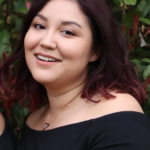 Aranza Torres has lived in Waco for a majority of her life (21 years!). She is a University High School graduate who continued her education out of state at Goshen College located in Goshen, IN. After graduating with a Bachelor of Social Work she returned to Waco to give back to her local community. She is currently a Recruiter and Dual Credit Advisor at McLennan Community College. In her spare time she enjoys being a part of the Waco Immigrants Alliance, Advisor to the MCC Hispanic Student Association, doing puzzles and spending time with her two large pitbull puppies (they’re not really puppies).
Aranza Torres has lived in Waco for a majority of her life (21 years!). She is a University High School graduate who continued her education out of state at Goshen College located in Goshen, IN. After graduating with a Bachelor of Social Work she returned to Waco to give back to her local community. She is currently a Recruiter and Dual Credit Advisor at McLennan Community College. In her spare time she enjoys being a part of the Waco Immigrants Alliance, Advisor to the MCC Hispanic Student Association, doing puzzles and spending time with her two large pitbull puppies (they’re not really puppies).
 Jon Singletary, PhD, MSW, MDiv, is dean and professor of the Diana R. Garland School of Social Work at Baylor University. He has served on faculty at Baylor since 2003. His wife teaches at Hillcrest PDS in Waco ISD and their children attend the Atlas Academy at Tennyson Middle School and Waco High School.
Jon Singletary, PhD, MSW, MDiv, is dean and professor of the Diana R. Garland School of Social Work at Baylor University. He has served on faculty at Baylor since 2003. His wife teaches at Hillcrest PDS in Waco ISD and their children attend the Atlas Academy at Tennyson Middle School and Waco High School.
By Jessica Maxwell
Being a professional transit operator isn’t easy, although many make it look that way. Professional operators must memorize routes, adhere to schedules, check and collect fares, give directions, answer questions, obey traffic laws, remember passenger requests, exercise sound judgment in stressful or emergency situations, assist passengers of all abilities and endure an array of weather conditions– all while safely maneuvering oversized vehicles through tight spaces and unpredictable traffic. An operator’s work day starts and ends with a complete pre/post-trip vehicle inspection, and any issues are reported to maintenance personnel. Safety is a top priority.
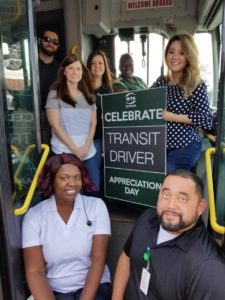 It’s a demanding career, but a rewarding one. People rely upon public transportation for increased mobility, affordable access to essential needs and improved quality of life. Those fortunate enough to own their vehicle might not always recognize the importance of public transportation, but professional operators witness, firsthand, its direct impact on the lives of passengers.
It’s a demanding career, but a rewarding one. People rely upon public transportation for increased mobility, affordable access to essential needs and improved quality of life. Those fortunate enough to own their vehicle might not always recognize the importance of public transportation, but professional operators witness, firsthand, its direct impact on the lives of passengers.
Waco Transit System, along with other transit agencies across the country, celebrated National Transit Driver Appreciation Day on Friday, March 16. This effort was started as a way to honor the hard-working men and women who keep our nation moving on a daily basis. With more than 1.3 million passenger trips in 2017 alone, Waco Transit System’s operators are certainly kept busy, and we are grateful for their service and commitment to our passengers and the community. Professional operators, along with vehicle maintenance personnel and other staff who work behind-the-scenes, deserve our heartfelt thanks and appreciation. A simple smile or wave when you board and a sincere “thank you” as you leave can go a long way.
While we believe every day is a good day to let your driver know how much they’re appreciated, it’s wonderful to see the country come together on one nationally-recognized day to celebrate the vital role professional operators play in public transportation.
For more information about this national effort, visit www.transitdriverday.org.
Have you thanked your professional operator(s) lately? Let us know why you appreciate your driver(s), and we’ll be sure to pass along your comments. Drop us a line at [email protected], Tweet us @WacoTransit or post a comment to our Facebook page (https://www.facebook.com/WacoTransit/).
 Jessica Maxwell is the Director of Marketing for Waco Transit System. She graduated from Northern Illinois University with a BA in Journalism and Communication Studies. Originally from Illinois, she moved to Texas with her husband in 2013, and they have been happily settled in Waco ever since. She enjoys spending time with her family, traveling and experiencing all the great outdoors has to offer. You can reach Jessica at [email protected].
Jessica Maxwell is the Director of Marketing for Waco Transit System. She graduated from Northern Illinois University with a BA in Journalism and Communication Studies. Originally from Illinois, she moved to Texas with her husband in 2013, and they have been happily settled in Waco ever since. She enjoys spending time with her family, traveling and experiencing all the great outdoors has to offer. You can reach Jessica at [email protected].
The Act Locally Waco blog publishes posts with a connection to these aspirations for Waco. If you are interested in writing for the Act Locally Waco Blog, please email [email protected] for more information.
By Craig Nash
I’ve been thinking about anger and its place in our public discourse and how we communicate with our neighbors.
I’m no techie, which makes it difficult for me to understand everything about Russian “bots,” data analysis, and all the other digital interference that has been in the news since the last Presidential election. But I do understand that it was (and is) more than an effort to elect a certain person to office or to sway public opinion about a particular issue. The ultimate goal is to create instability and to sow chaos. To make us so angry at each other that we don’t trust the motives of our neighbor. And it has worked. We’ve all chosen our tribes and are yelling at each other across the expanse.
This is unsettling. Though I love an entertaining argument among friends, it is always with the assumption that, once it is over, both sides are able to lay down their swords and enjoy a drink of choice together. There’s a point, however, where arguing seems counterproductive and dangerous. Though I fail at this often, there’s a point when I want us to talk to each other more calmly, rationally and respectfully.
I am also aware, however, of this: The last sentence I wrote in the previous paragraph is a product of my place in society. Calm, rational and respectful dialogue is the goal of those of us with privilege. For me, it is a privilege my whiteness, straightness and maleness to demand “calm, rational respect” occur during dialogue. It’s also a privilege for me to DEFINE what is meant by calm, rational and respectful. Demanding these things in conversation about big issues allows people like me to control the conversation and, more often than not, maintain the status quo.
So, there are these two things I hold in tension—The need to talk to each other more calmly and respectfully on one hand, and on the other, the realization that my wanting this is a result of my place in the world.
We have a lot of calls for calm dialogue in our country. At least once a week I see a news show convene a group of people with disparate opinions on a given topic to have a dialogue. It usually ends with an exhale by the moderator and a calm, sweet, “Now wasn’t that nice? No one got angry. You listened and spoke to each other with respect.” What we don’t often hear is a defense of anger and emotion. So I decided to ask some of my friends who are experts in being told to be more calm and rational—women—what they thought about these ideas ruminating in my mind. Their responses were instructive, and rather than giving commentary on what I learned, I wanted to share directly some of the things they had to say.
Respondent #1 (In addition to being female, also a Person of Color.): “…We want to trust our neighbors but that does require them to speak out and risk giving up some of their privilege and protection which is not easy to do…. I know that for myself and other friends of Color that we are not in place that we can filter or code switch* at all. Being polite and speaking reasonably is something we have done for so long that we end up taking ourselves completely out of those spaces and conversations to maintain our sanity, but also so that we don’t do irreparable damage to those people we care about while we wait for the conversation to shift.”
(*Note: “Code Switching” in this context refers to modifying behavior, tone, dialect, appearance, etc. in order to accommodate to the social norms of another — usually dominant — group.)
Respondent #2: “Anger as an emotion is a good thing. It’s an alarm bell that says you are being violated… The problem isn’t anger, the problem is injustice. Anger is the right of the oppressed, and blaming anger for our problems mislabels the problem. That being said, how we wield anger is important…. I am less and less convinced that civil discourse is the answer…at least, it cannot be the answer when “civil” discourse favors the privilege and the status quo, which it so often does. I’m not saying we ought to yell profanities and call names…I’m just saying anger is not the enemy here. You can be very angry and still say things that are true and constructive.
At this point I anticipate the pushback to these thoughts about anger, which often takes some form of this question: “Ok, I hear you. But what do you want me to do.”
Respondent #3: “People seem to want to circumvent the understanding part. ‘let’s just make the changes and be done with it.’ (i.e. I don’t want to feel anything, I want to be efficient with my time which means let’s get to a solution) Majority members don’t seem to have time to hear the pain or anger often.”
Respondent #4: Many times marginalized groups have tried polite civil discourse, and have not been listened to. Then, when they speak with frustration and anger, they are criticized. As a society we say, oh well I would listen to you if you weren’t so angry/emotional, when in truth many groups have tried that and gone unheard. Calling for civility has been a way that our society has attempted to quiet or sidestep uncomfortable conversations. That being said, I do think civil discourse has its place especially if trying to reach beyond someone’s instinctual tribal reactions. Also speaking from privilege as a white female, speaking calmly and politely has helped me deescalate many situations, but it has also forced me to not ask for what I needed out of a situation for the sake of everyone getting along.
I think everyone would agree that we live in turbulent times. Maybe not any more turbulent than other times, but the stakes seem heightened. From national issues of gun violence, immigration and race relations, to local conversations about the fate of our schools and the location of our landfills, we are all bumping into each other’s worldviews and opinions in ways that can feel uncomfortable. What I have learned from these women is that this discomfort may be needed. Or, perhaps, the discomfort that certain groups have owned as a part of their inheritance needs to be shifted onto those of us for whom discomfort is foreign.
 Craig Nash has lived in Waco since 2000. Since then he has worked at Baylor, been a seminary student, managed a hotel restaurant, been the “Barnes and Noble guy,” pastored a church and once again works for Baylor through the Texas Hunger Initiative. He lives with his dog Jane, religiously re-watches the same 4 series on Netflix over and over again, and considers himself an amateur country music historian.
Craig Nash has lived in Waco since 2000. Since then he has worked at Baylor, been a seminary student, managed a hotel restaurant, been the “Barnes and Noble guy,” pastored a church and once again works for Baylor through the Texas Hunger Initiative. He lives with his dog Jane, religiously re-watches the same 4 series on Netflix over and over again, and considers himself an amateur country music historian.
The Act Locally Waco blog publishes posts with a connection to these aspirations for Waco. If you are interested in writing for the Act Locally Waco Blog, please email [email protected] for more information.
by Melissa Mullins
Most people have heard of Earth Day, celebrated on April 22 each year and started in 1970 when millions of Americans demonstrated in protest against deterioration of the environment. But not as many people are aware of World Water Day, celebrated on March 22 every year. Every year you can find World Water Day information on worldwaterday.org , including the theme for the year.
This year’s theme is “The Answer is in Nature” and explores issues around how we can reduce floods, droughts, and pollution. As stated on the website “damaged ecosystems affect the quantity and quality of water available for human consumption. Today, 2.1 billion people live without safe drinking water at home; affecting their health, education, and livelihoods.” Communities around the globe, including in Texas, host celebrations for World Water Day.
Don’t limit World Water Day to one day of the year! Practice conservation and water-friendly living practices throughout the year in your daily life. There are many ways to conserve and protect water. We’ve probably all heard about tips like fixing leaky faucets, or not over-watering or over-fertilizing our yards, or picking up pet wastes. But what about “hidden” uses of water? Baylor University’s Center for Reservoir and Aquatic Systems Research offers a monthly virtual classroom visit for schools, and on this month’s visit a student asked “what can I do to conserve water?” And the CRASR scientist answered “turn off the lights!” –you may not think about it, but electricity generation is a HUGE water user!
In addition to observing water-friendly living practices in our personal lives, citizens can have a voice in decision-making around water issues in our community. Water planning in Texas is coordinated through a state water planning process, and locally we are in the Brazos G Regional Water Planning Group which meets here in Waco at the Brazos River Authority offices. Meetings are open to the public and there are opportunities to serve. The City of Waco has the Sustainable Resource Practices Advisory Board, whose purpose is “to advise the City Council on the development and/or support of ecological and environmentally sound programs and policies within Waco”, which certainly includes water!
The Center for Reservoir and Aquatic Systems Research at Baylor University has often supported Citizen Science efforts for monitoring local water bodies by schools as part of the World Water Monitoring Challenge. If you have ideas about events you’d like to see for World Water Day next year in Waco, let’s talk!
 Melissa Mullins is an aquatic scientist who coordinates education and outreach at Baylor’s Center for Reservoir and Aquatic Systems Research. She is a Baylor alum (M.S. Environmental Biology ’95) and is on the Board of the Informal Science Education Association of Texas which focuses on promoting science learning outside the classroom. She loves goats and yoga and recently visited the Nile River in Uganda as part of a Baylor trip. She believes that a vibrant scientific community that includes the public in its work is a fundamental underpinning of a democratic society.
Melissa Mullins is an aquatic scientist who coordinates education and outreach at Baylor’s Center for Reservoir and Aquatic Systems Research. She is a Baylor alum (M.S. Environmental Biology ’95) and is on the Board of the Informal Science Education Association of Texas which focuses on promoting science learning outside the classroom. She loves goats and yoga and recently visited the Nile River in Uganda as part of a Baylor trip. She believes that a vibrant scientific community that includes the public in its work is a fundamental underpinning of a democratic society.
The Act Locally Waco blog publishes posts with a connection to these aspirations for Waco. If you are interested in writing for the Act Locally Waco Blog, please email [email protected] for more information.
(With this post we are kicking off a new regular series “Trails & Trials,” a monthly adventure series inspiring others to experience the physical, mental, and social benefits of cycling, running or swimming in Central Texas . Keep an eye out for more posts in coming months! – ALW)
By Natasha van der Merwe
I’ll never forget the day Kevin walked into my office where I was director of triathlon. He was 70, and he wanted to know how to prepare for his first triathlon.
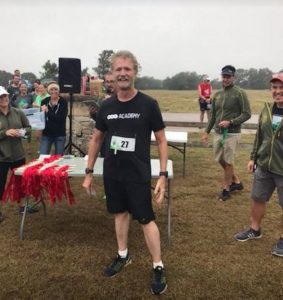 He had some swimming experience, a very old Schwinn bike and the will to get through the run, even if it meant doing a lot of walking.
He had some swimming experience, a very old Schwinn bike and the will to get through the run, even if it meant doing a lot of walking.
He jumped in head first to training. He never missed a practice or an opportunity to ask a coach a question about how he could improve. The questions were limitless: How can I improve my swim form? What should my cadence be on the bike? What should my heart be on the run? How can I fuel my body for the best performance?
Kevin embodies one of the biggest reasons so many people are drawn to our sport. Trying to conquer three different sports in the quickest time possible is a challenge that not only attracts people, but hooks them in for life. Because just as in life, in triathlon, there is always an opportunity for improvement.
I came into the sport pretty late, too, compared to many of my competitors who started as junior triathletes.
At 27, I was a tennis coach, putting all my hours into helping others reach their full potential. But, I also longed to find something to feverishly pursue for myself.
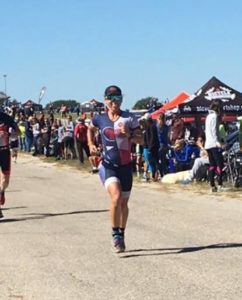 Enter triathlon. A friend entered me into my first race, and I was hooked. I still don’t know how I did not find this sport sooner.
Enter triathlon. A friend entered me into my first race, and I was hooked. I still don’t know how I did not find this sport sooner.
Like most and like Kevin, I started with a sprint triathlon, a 500-meter swim, 12-mile bike and 5K run.
I hadn’t been in the pool since my junior school swim team days. A lot had changed, and I was fortunate to have a swim coach to watch my stroke and give me pointers. With a few swims before race day, I knew I wasn’t going to drown.
A friend was kind enough to take me out riding and teach me how and when to shift gears. I soon found myself riding with a group from the local bike store. It was one of the most joyous times in my life; feeling the wind and sun on my back, taking in the beauty of the countryside, getting the endorphin high of exercise all while chatting away with the person riding next to me. My best friends to this day are those who I bike and run with.
Running was the easy part – logistically anyway. All I needed was a pair of running shoes from my local running store and a Garmin watch because it’s always more fun to see how far and fast I’ve gone.
One of the best parts of triathlon, I’ve found, is the opportunity to build lifelong friendships, and meet people like Kevin, who are determined to give it their all no matter their stage in life. Want to join a community of other fitness enthusiasts or triathletes? Waco has lots of options and everyone’s welcome at Waco Bike Club, Waco Triathlon Club, or Waco Striders. Need some expert advice on equipment or nutrition? Stop by Bicycle World Waco or Waco Running Company any day of the week. There’s nothing like being fully accountable and equipped. It gets you up in the morning, and pushes you to start your day with a great sweat session.
So why sign up now for your first 5k or sprint triathlon? Because you’re never too old to take on new challenges. Just ask Kevin. Or me. And because sport will give you the energy and confidence it did when you were growing up and will help you be a role model for your kids, too.
Here’s just a short list of the benefits:
- Work ethic – a commitment to preparing for race day, because there is no faking a triathlon.
- Discipline – Getting up in the early morning to train stinks at first, but soon you won’t be able to start your day without those endorphins.
- Time management – To fit everything in with your busy life, you’ll have to prioritize.
- Goal setting – You know you’ll want to beat your office friend or training buddy who entered the race, too.
- Perseverance – It won’t be all smooth sailing, so you’ll have to learn to problem solve and stay mentally strong despite setbacks. (Pro tip: If you’re struggling, it’s usually because you aren’t eating and sleeping enough. Do that right and smoother waters are ahead.)
- Confidence – Something we all need more of.
- Pride – Hard work does yield gratifying results.
At 70, Kevin found all those benefits and is still pursuing his triathlon goals more than two years later. For me, triathlon gave me the structure and the goals I needed to channel all of my passion into a growing career in sport while being a role model for my toddler daughter.
What will it give you? You never know til you tri. But I can guarantee you, it will be worth it.
 The Tenth Annual TriWaco Triathlon will be on Sunday, July 15, 2018. Registration opens on Sunday, Nov. 5, 2017! The race starts with a 1500-meter open water swim in the Brazos River followed by a mostly flat and fast 25-mile bike ride on country roads north and west of Waco. The race finishes out with a hilly 10-kilometer run along the Brazos River that leads to the oldest suspension bridge in Texas. The Sprint distance event includes a 400-meter swim in the Brazos River, a 12-mile bike ride along the same country roads and a 3.5-mile run finishing on the suspension bridge. For more information, visit the website: triwaco.org
The Tenth Annual TriWaco Triathlon will be on Sunday, July 15, 2018. Registration opens on Sunday, Nov. 5, 2017! The race starts with a 1500-meter open water swim in the Brazos River followed by a mostly flat and fast 25-mile bike ride on country roads north and west of Waco. The race finishes out with a hilly 10-kilometer run along the Brazos River that leads to the oldest suspension bridge in Texas. The Sprint distance event includes a 400-meter swim in the Brazos River, a 12-mile bike ride along the same country roads and a 3.5-mile run finishing on the suspension bridge. For more information, visit the website: triwaco.org
 Natasha van der Merwe is originally from South Africa. She is mom to a 19-month old girl, former professional tennis player and tennis instructor, and a professional triathlete representing Bicycle World and Waco Running Company. She has multiple top 10 finishes in Ironman and 70.3 events around the world. She is Director of Team Programs for Bicycle World, Texas
Natasha van der Merwe is originally from South Africa. She is mom to a 19-month old girl, former professional tennis player and tennis instructor, and a professional triathlete representing Bicycle World and Waco Running Company. She has multiple top 10 finishes in Ironman and 70.3 events around the world. She is Director of Team Programs for Bicycle World, Texas
(During these last few weeks of December we will be reprising the Top 10 Most Opened Blog Posts for 2018 from the Act Locally Waco blog. I couldn’t possibly pick my favorites – so I used the simple (cop out?) approach of pulling up the 10 blog posts that got the most “opens” according to our Google Analytics. It is an intriguing collection that gives at least a little insight into the interests and concerns of Act Locally Waco readers. I hope this “Top 10” idea inspires you to go back and re-read your personal favorites. There have been so many terrific ones… If you would like to see the Top 10 according to Google Analytics, here’s the link: Top 10 Most Opened Blog Posts of 2018. Merry Christmas! — ABT)
By Ashley Bean Thornton
I went to the “March for our Lives” rally Saturday, but I did not really want to go.
I do not like political rallies and protest marches.
Sure, I can appreciate a clever sign and an inspiring speech as much as anyone, but once the initial emotional high has worn off, I feel bad.
I want to believe people can work together to understand each other’s points of view and to find a way forward together when it comes to difficult issues. Once the PA system and the signs come out, however, I feel like we aren’t trying to understand each other and work together any more…we are trying to make sure our side wins.
I have a democrat sticker on my car and I have heard people say that means I hate guns. I don’t hate guns. I would characterize my feeling toward guns as neutral.
I don’t personally own a gun. They are not interesting to me, so I spend my money on other things. Also, I am pretty much blind in one eye…the one you need for shooting it turns out. So, there’s that.
But, I don’t hate guns. Many of my friends have guns for all kinds of different reasons… hunting, protection, fun. I don’t have any problem with that. I don’t have any problem with you carrying your gun in your purse or your pocket or your holster or your pick-up truck. If you are not using your guns to shoot innocent people, and you are keeping your guns away from little kids, then I don’t have any problem with your guns.
I do not hate guns. Most of the time I don’t even care about or think about guns.
One reason I have the luxury of not caring about guns is that most of the people who do own guns are very responsible with their guns. Most gun owners are responsible. I get that.
I also get that responsible people don’t like having their rights and privileges abridged because of the behavior of irresponsible people. I don’t want my car taken away because someone else drinks and drives. I don’t want my cell phone taken away because someone else texts and drives. You don’t want your guns taken away or your gun ownership made inconvenient because some other guy was irresponsible. I get that.
Also, I believe that some (maybe most) gun owners “get” some of things that are important to me. For example, I am fine with a whole lot of people having guns, but there are some exceptions. I am not fine with unsupervised teenagers having guns that can kill people. I am not fine with certain kinds of criminals having guns. I am not fine with mentally unstable people having guns.
I bet most gun lovers can understand why I believe some people ought not to have guns. I believe we could have a fruitful conversation about where to draw those lines and how to enforce them. I believe we could make some headway that would keep us all safer.
When it comes to “assault guns” or “AR-15’s” or whatever the right word is for guns that fire many, many bullets incredibly quickly…I don’t like them, but I can understand why some people might not want to have them banned completely. I bet most gun lovers can understand why I think the standards and rules for owning such a dangerous weapon should be very, very strict. I bet if we got in a room together with the goal of coming up with rules we could both live with on this matter, we could come up with something that would move us down the road.
There have always been and always will be trade-offs between freedom and safety. We can’t protect ourselves or our children from every harmful person, but we can work together to get better at it than we are doing now. I believe that’s what we should do. Or more to the point, I believe that is what our elected representatives should be doing in our names.
I don’t really like rallies and marches because I feel like, if we are not careful, they become opportunities for vilifying each other, reinforcing our worst opinions about each other and making it harder than ever to work together.
So why did I go to the “March for our Lives?” Honestly, I succumbed to peer pressure. My friends were going, so I did. And, despite my misgivings, I’m glad I did.
The young people who spoke were magnificent! Smart and poised and well-reasoned, they gave me hope for the future of our country.
Also, bluntly, the way I wish we would work together doesn’t seem to be working.
As I stood in the sun listening to the speeches, I thought about how long we have been trying to figure out how to protect our children and ourselves, and it seemed to me we have made no progress.
As I looked around at the crowd of hundreds in Waco (and the pictures that showed crowds of thousands, and possibly hundreds of thousands in other cities) I thought, “I guess this is what it takes to make progress. It takes bodies getting out into the street. It takes showing the sheer physical mass of people who care about an issue. This is what it takes to get an issue on the table.” I understand this is what it takes, and I am so very grateful to those hardworking souls who are making it happen, but I still wonder why … why can’t we just talk? I wish we could.
 This Act Locally Waco blog post is by Ashley Bean Thornton, she has lived in Waco almost 20 years now. Far longer than she ever lived anywhere else. She likes to walk. If you see her out walking, honk and wave and say “hi!”
This Act Locally Waco blog post is by Ashley Bean Thornton, she has lived in Waco almost 20 years now. Far longer than she ever lived anywhere else. She likes to walk. If you see her out walking, honk and wave and say “hi!”
The Act Locally Waco blog publishes posts with a connection to these aspirations for Waco. If you are interested in writing for the Act Locally Waco Blog, please email [email protected] for more information.
